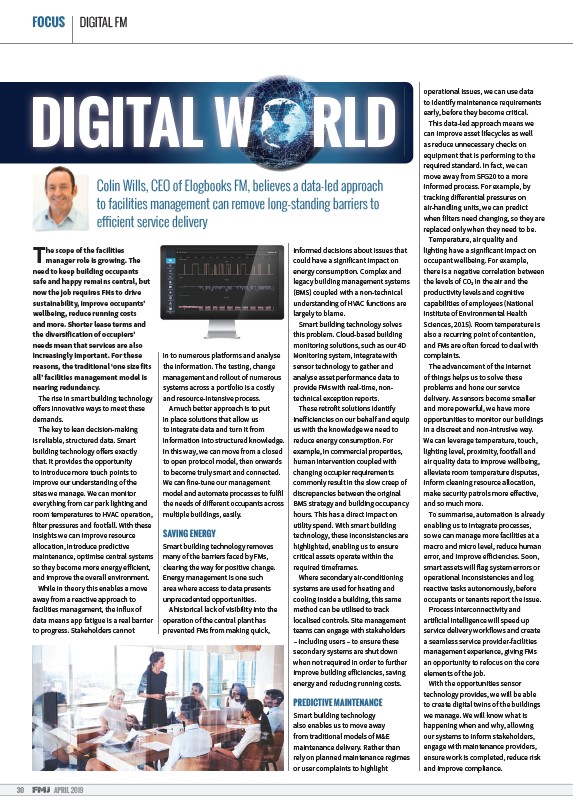
FOCUS DIGITAL FM
DIGITAL W RLD
30 APRIL 2019
Colin Wills, CEO of Elogbooks FM, believes a data-led approach
to facilities management can remove long-standing barriers to
eƝ cient service Gelivery
The scope of the facilities
manager role is growing. The
need to keep building occupants
safe and happy remains central, but
now the job requires FMs to drive
sustainability, improve occupants’
wellbeing, reduce running costs
and more. Shorter lease terms and
the diversification of occupiers’
needs mean that services are also
increasingly important. For these
reasons, the traditional ‘one size fits
all’ facilities management model is
nearing redundancy.
The rise in smart building technology
o ers innovative ways to meet these
demands.
The key to lean decision-making
is reliable, structured data. Smart
building technology o ers exactly
that. It provides the opportunity
to introduce more touch points to
improve our understanding of the
sites we manage. We can monitor
everything from car park lighting and
room temperatures to HVAC operation,
filter pressures and footfall. With these
insights we can improve resource
allocation, introduce predictive
maintenance, optimise central systems
so they become more energy e icient,
and improve the overall environment.
While in theory this enables a move
away from a reactive approach to
facilities management, the influx of
data means app fatigue is a real barrier
to progress. Stakeholders cannot
a ord the time to log
in to numerous platforms and analyse
the information. The testing, change
management and rollout of numerous
systems across a portfolio is a costly
and resource-intensive process.
A much better approach is to put
in place solutions that allow us
to integrate data and turn it from
information into structured knowledge.
In this way, we can move from a closed
to open protocol model, then onwards
to become truly smart and connected.
We can fine-tune our management
model and automate processes to fulfil
the needs of di erent occupants across
multiple buildings, easily.
SAVING ENERGY
Smart building technology removes
many of the barriers faced by FMs,
clearing the way for positive change.
Energy management is one such
area where access to data presents
unprecedented opportunities.
A historical lack of visibility into the
operation of the central plant has
prevented FMs from making quick,
informed decisions about issues that
could have a significant impact on
energy consumption. Complex and
legacy building management systems
(BMS) coupled with a non-technical
understanding of HVAC functions are
largely to blame.
Smart building technology solves
this problem. Cloud-based building
monitoring solutions, such as our 4D
Monitoring system, integrate with
sensor technology to gather and
analyse asset performance data to
provide FMs with real-time, nontechnical
exception reports.
These retrofit solutions identify
ine iciencies on our behalf and equip
us with the knowledge we need to
reduce energy consumption. For
example, in commercial properties,
human intervention coupled with
changing occupier requirements
commonly result in the slow creep of
discrepancies between the original
BMS strategy and building occupancy
hours. This has a direct impact on
utility spend. With smart building
technology, these inconsistencies are
highlighted, enabling us to ensure
critical assets operate within the
required timeframes.
Where secondary air-conditioning
systems are used for heating and
cooling inside a building, this same
method can be utilised to track
localised controls. Site management
teams can engage with stakeholders
– including users – to ensure these
secondary systems are shut down
when not required in order to further
improve building e iciencies, saving
energy and reducing running costs.
PREDICTIVE MAINTENANCE
Smart building technology
also enables us to move away
from traditional models of M&E
maintenance delivery. Rather than
rely on planned maintenance regimes
or user complaints to highlight
operational issues, we can use data
to identify maintenance requirements
early, before they become critical.
This data-led approach means we
can improve asset lifecycles as well
as reduce unnecessary checks on
equipment that is performing to the
required standard. In fact, we can
move away from SFG20 to a more
informed process. For example, by
tracking di erential pressures on
air-handling units, we can predict
when filters need changing, so they are
replaced only when they need to be.
Temperature, air quality and
lighting have a significant impact on
occupant wellbeing. For example,
there is a negative correlation between
the levels of CO2 in the air and the
productivity levels and cognitive
capabilities of employees (National
Institute of Environmental Health
Sciences, 2015). Room temperature is
also a recurring point of contention,
and FMs are o¡ en forced to deal with
complaints.
The advancement of the internet
of things helps us to solve these
problems and hone our service
delivery. As sensors become smaller
and more powerful, we have more
opportunities to monitor our buildings
in a discreet and non-intrusive way.
We can leverage temperature, touch,
lighting level, proximity, footfall and
air quality data to improve wellbeing,
alleviate room temperature disputes,
inform cleaning resource allocation,
make security patrols more e ective,
and so much more.
To summarise, automation is already
enabling us to integrate processes,
so we can manage more facilities at a
macro and micro level, reduce human
error, and improve e iciencies. Soon,
smart assets will flag system errors or
operational inconsistencies and log
reactive tasks autonomously, before
occupants or tenants report the issue.
Process interconnectivity and
artificial intelligence will speed up
service delivery workflows and create
a seamless service provider-facilities
management experience, giving FMs
an opportunity to refocus on the core
elements of the job.
With the opportunities sensor
technology provides, we will be able
to create digital twins of the buildings
we manage. We will know what is
happening when and why, allowing
our systems to inform stakeholders,
engage with maintenance providers,
ensure work is completed, reduce risk
and improve compliance.